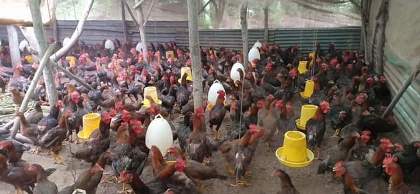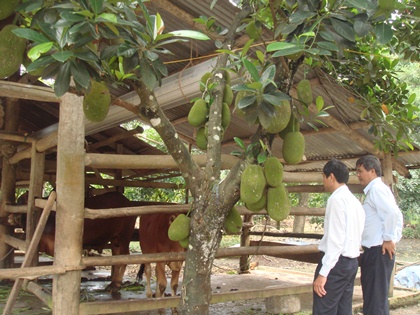
Chicken are one of the province’s main domestic
animals
* Efforts have been made to prevent diseases
According to the data released by the provincial
Statistics Office, in December, 2019 the total number of cattle reached 2.18
million heads, down by 14%. In particular, the total number of pigs was
approximately 2 million heads, down by 14.75% over the same period last year.
The province’s cow herds in recent years have tended to increase slightly, from
nearly 75,000 cows in 2017 to about 86,000 cows. The cow herds increased due to
the fact that some enterprises have invested in importing cows and then raising
them for beef. The province’s water buffalo herds are relatively small, about
3,770 heads. The number of goats is about 277,000 heads but livestock activities
are mainly small-scale, scattered and concentrated in Long Thanh, Trang Bom, Tan
Phu, Thong Nhat and Xuan Loc districts.
In terms of raising poultry, the province’s chickens
have developed well and major domestic animals with a total number of about
25.65 million heads. Compared to other types of livestock animals, raising
chickens has an advantage of economic efficiency due to short cycles, quick
multiplying co-efficiency and the fact that some big companies have farmers
raise chicken for processing, which facilitates a growing number of chickens.
The number of chickens is mainly raised for meat on a farm scale with the
varieties of industrial chickens, which are raised for meat and with colored
chickens with the rate of using advanced technical varieties in production of
above 90%. Other types of chickens are approximately two million ducks,
ducklings and geese, which are mainly in the districts of Tan Phu, Xuan Loc,
Vinh Cuu and Thong Nhat. The quail population is about 6.8 million heads, which
are mainly distributed in Trang Bom, Thong Nhat, Vinh Cuu and Xuan Loc
districts.
The area for fishery farming reaches about 32,000
hectares, about 30,000 hectares of which are for freshwater fishery farming and
2,000 hectares of which are for brackish water fishery farming. The total number
of cages and rafts is about 1,000, which are concentrated Dong Nai river, Tri
An reservoir and Nuoc Lon area in Nhon Trach district.

It is necessary to proactively prevent and control
animal diseases
In 2019, African swine fever entered local areas and
caused damage to the province’s livestock sector with more than 449,000 culled
pigs. Departments, sectors and localities and concerned agencies have focused on
and actively taken measures to prevent and control diseases like conducting the
culling of sick pigs and those that are suspected of being sick or die with
unclear reasons; supporting farmers with losses; setting up temporary quarantine
posts to control the transport of pigs and pig products; disinfecting epidemic
areas, and areas threatened by or kept under control of the epidemic; and so on.
Up to now, 120 out of 137 communes and wards have gone over 30 days without a
re-occurrence of the epidemic.
In addition, foot and mouth disease has occurred in
107 households and 1 farm, and the number of pigs that died and were culled hit
nearly 2,000. There were 97 pigs with blue ear disease and 56 others were
culled. Avian influenza occurred in 7 households and more than 28,000 birds had
to be culled.
Implementing epidemic prevention measures,
departments, sectors and localities have stepped up their dissemination of
propaganda information in various forms, means and contents related to dangerous
diseases on animals to raise people’s awareness so that farmers can promptly
detect diseases; called for farmers to regularly disinfect their breeding areas
and have their animals vaccinated against diseases. Also, farmers mustn’t hide
away outbreaks, say not to sales of sick animals and poultry, and never dump the
bodies of dead animals and poultry.
In parallel, it is essential to give vaccines too
cattle and poultry and establish facilities and disease-free areas. In 2019, 43
farms were granted with “disease-free” certificates. Up to now, the total number
of facilities having been recognized to be safe from diseases is 609; 5
districts including Dinh Quan, Vinh Cuu, Long Khanh, Thong Nhat and Trang Bom
have been recognized to be an area free of diseases on chickens, bird flu and
Newcatsle by the provincial Department of Veterinary.
*Necessary to continue to promote the prevention
and control of diseases in livestock activities
The provincial Department of Agriculture and Rural
Development has just issued a plan on how to prevent and control diseases on
domestic animals, poultry and fisheries in Dong Nai province in 2020 with the
aim of being proactive to prevent and control animal diseases effectively;
control and eliminate the disease if it is early detected and in a small area to
get ready for responding to and cope with it to minimize the risk of spreading
new diseases; ensure production, livestock and fishery farming activities and
protect people’s health and the province’s socio-economic development; reduce
the spread of pathogens and prevent animals from being infected with pathogenic
viruses and outbreaks to contribute to developing livestock activities in a
sustainable manner; and prevent diseases effectively, especially making
vaccination plans for compulsory diseases on animals effectively.
Department of Agriculture and Rural Development
asked localities to proactively design plans and allocate funding in accordance
with each locality’s practical conditions; take synchronous measures to prevent
and combat diseases; prepare sufficient human resources and equipment that are
necessary for the prevention and control of epidemics; and be ready to respond
in cases of an occurrence of epidemics.
Also, it is necessary to organize compulsory
vaccination programs against diseases on cattle and poultry as required;
disseminate propaganda information and prevention and control measures against
diseases on domestic animals, poultry and fisheries in order that people can
know and voluntarily follow them; develop a disease surveillance system at
grassroots to provincial levels and take effective disease treatment measures as
required.
For the African swine fever epidemic, localities
need to have more directions to strengthen their disease surveillance activities
in hamlets for detecting outbreaks early, encircling and settling pig sales,
slaughtering and transiting sites; organize the month of cleaning and
disinfecting breeding areas, markets, and the sites for slaughtering and trading
pig products with powdered lime or chemicals and so on.
According to their functions and tasks, concerned
departments, sectors and units are supposed to make their specific plans to
organize and coordinate to start plans to prevent and control diseases on
domestic animals, poultry and fisheries in 2020 successfully.
Duy Minh (P. Nga)